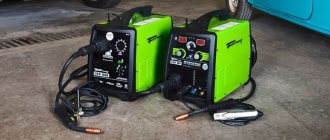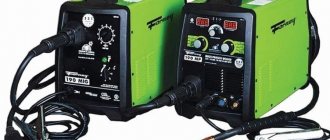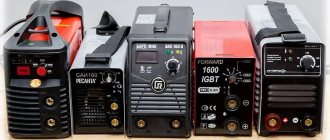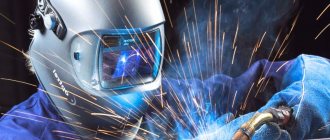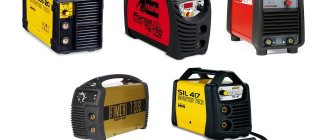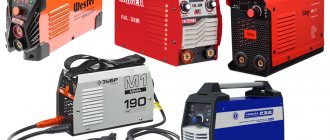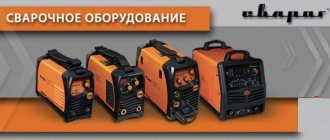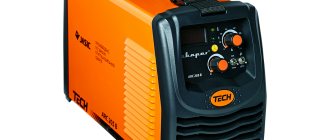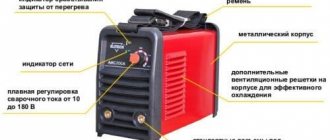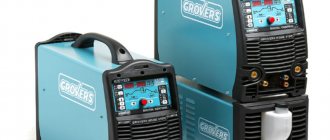Content
- About prices and brands
- Classes of welding inverters. Application area
- Types of welding inverters by functionality
- Input voltage
- Welding current strength and electrode diameter
- Duration of load
- No load voltage
- Insulation class
- Additional modes and functions
- Conclusion
Back in the middle of the 20th century, only transformer machines were used for welding work. They had very significant dimensions, and working with them was not always convenient. Already in the 70s, welding inverters began to appear. They, unlike transformers, are capable of repeatedly converting current, that is, inverting. Thanks to this ability they got their name.
The welding inverter receives alternating current from a regular consumer electrical network (220 V) or industrial three-phase (380 V), inverts it into direct current, then again converts it into high frequency alternating current from 20 to 50 kHz, and then also reduces the voltage to 70–90 Volt with an increase in current to 100-200 A. The result is a high-frequency current with parameters necessary for welding work.
Now manufacturers of welding equipment produce, among other things, models for domestic use. We will talk in detail about how to choose a welding inverter, what parameters to pay attention to and what type to give preference in this article.
Let's start, as always, with the most popular question: how much can a good welding inverter cost?
Fast and Furious 161
In fifth place in our rating is the domestic welding machine Forsazh 161. Own development of JSC State Ryazan Instrument Plant. This is one of those devices that you can be proud of that was made in Russia. An inverter circuit is used to convert the current. The plant also produces avionics for 5th generation fighters, so the standards and requirements for the quality level of products are the highest. The inverters are assembled by qualified personnel. Advanced technologies and modern equipment are used in the production process. Actually, there is no need to talk about the artisanal assembly of the devices (which at first glance is typical of domestic welding equipment). The Fast and the Furious devices are high-quality equipment with aviation reliability (if you believe the advertising). “Aviation” may sound pretentious, but it is already a fact that the Ryazan people managed to make a kind of breakthrough in inverter technology. Fast and Furious has already become a favorite among welders and the popularity of welding machines under this brand is increasing and will continue to grow if the engineers of the instrument plant continue to improve inverters (which will reduce the final cost of the equipment while maintaining its quality). Already today, Fast and Furious 161 costs almost the same as its Chinese counterpart AURORA 160 (PRO STICKMATE), which took 4th place in our rating. Both devices are often compared and, to be honest, it is difficult to give one a clear preference. We gave Aurora 4th place only because, after all, our citizens still have strong negative stereotypes and prejudices towards domestic technology and therefore many, contrary to logic and common sense, prefer to take a lower-quality China rather than a good Russia (albeit to China the relationship is twofold). It is difficult to say about other production areas, but as for Ryazan welding equipment, this stereotype is gradually being broken. It was the Fast and Furious 161 device that broke the vicious circle, its predecessor, which, by the way, has nothing in common with today’s model, except for a similar name; Fast and the Furious 160 was not very successful, even though it had 100 percent PV. And all because of the very high cost. And now, we have finally managed to achieve the optimal price-quality ratio.
Forsazh 161 is the undisputed leader in specific power (specific current strength 22 mA/cm3). An inverter weighing just over 4 kg cooks with both “three” and “four” (electrodes o3 mm and o4 mm). The welding process is highly stable, as they say “cooks confidently”, the current is smoothly regulated from 10 to 160A. PV at current 100 A - 100%, 120 A - 80%, 160 A - 40%.
The optimal settings of the device were calculated in leading scientific centers of Russia and included in the control algorithm. All functions designed to make the work of both a novice and an experienced welder easier on this machine are present not only in the passport data. Unlike Chinese welding equipment, when some of the declared functions are missing or not at all, in Fast and Furious 161 everything is present de facto and works correctly:
- “hot start” is responsible for simple ignition of the arc - easy start of welding;
- “Arc force” prevents sticking when you bring the electrode too close to the surface of the metal being welded;
- "Anti-stick" will automatically turn off the welding current if there is a short circuit.
This is why it is a Russian inverter, because it necessarily provides for the possibility of welding at low voltage in the network. Who, if not the Russians, does not know what problems can occur with the power grid; neither Chinese nor European specialists can understand this! Therefore, the inverter is maximally adapted to our Russian realities. The manufacturer’s website states that the inverter can cook at a reduced voltage from 160V in the network. In practice we are even talking about 140V. It’s clear that we’re not talking about full-fledged welding in such conditions, but you can grab something and even weld it with a small-diameter electrode.
"Inside"
The inverter is created using high-quality components from Europe and the USA. Unlike low-quality budget Chinese inverters, the Forsazh 161 electronics ensure stable operation throughout its entire service life. Generally speaking, the claim for quality of execution and functionality is at the level of world leaders. And if we compare the device with European analogues, then we are talking about a significant advantage in price (remember that the price is almost equal to Chinese analogues).
Fast and Furious 161 is microprocessor controlled. The ATMEGA 48 microcontroller, G50N60HS power switches and 150EBU02 power diodes are responsible for the smooth operation of the device and ease of welding. The power part is effectively cooled by blowing with a powerful fan, which starts only when it heats up. The advantages of such a system are obvious - the less the fan runs, the less dust is drawn under the case. Let us remind you that dust is the reason for calls to service centers in 80% of cases.
The device is built according to an oblique bridge design like PICO162 or Kemppi150. This circuitry has proven itself well in practice. The afterburner works with a long extension 100 mm long and a cross section of 12-16 mm2 (tested).
The inverter is not equipped with an electrode holder, ground terminal and welding cable. You can always choose the best quality option for you. Chinese inverters are equipped with a toy holder and a mass for disposal. The cable is often aluminum. Here the Ryazan people acted honestly - instead of “selling” rubbish, they give the buyer an independent choice. You can also purchase separately from the manufacturer a welding kit from ABICOR BINZEL (a good German manufacturer).
We also found a significant drawback in Fast and Furious 161, which does not affect its technical characteristics. This is the appearance; here the inverter is much inferior to its competitors. It looks simple: a metal box, sharp corners. Ryazan residents did not consider it profitable to invest money in an attractive design (the main content is the content, not the wrapper!). There was a model with a plastic control panel (the device certainly looks better with it), but it did not go into production because plastic had to be cast! (which apparently requires the purchase of expensive equipment). There was an option to cast a plastic panel in China, but over time it was abandoned. Be that as it may, Fast and Furious 161 still looks the way it does.
About prices and brands
If you study the catalogs of Belarusian online stores, you can find more than 80 brands presenting their products. It must be admitted that the absolute majority are either companies from Southeast Asia (China, Taiwan), or manufacturers registered in European countries, but also assembling their equipment in the Middle Kingdom.
Manufacturers with Russian names (Stavr, Soyuz, Zubr, etc.) most often also prefer to locate production in Asia or assemble products from Chinese components. Perhaps only Interskol can afford its own production in Russia.
However, if previously everything Chinese did not inspire confidence, now we can note several brands whose products are popular due to their good quality and relatively low price. These include Patriot and Solaris. Welding inverters from leading Scandinavian, European and American brands have traditionally high quality, but also a high price.
Semiautomatic welding machine Fubag IRMIG 200 with torch
For a clearer picture, let’s conditionally divide all the presented models into several price categories.
From 100 to 200 rubles
. In this price category only equipment for domestic use. As a rule, these are machines for manual arc welding (MMA) and with the possibility of argon arc welding (TIG). The current strength in most cases is limited to 200 Amperes. The duration of the load varies from 6 to 80%. Mostly, welding inverters from Chinese manufacturers cost up to 200 rubles. Equipment from Patriot, Edon and Solaris receive relatively good reviews. Single models in this category are represented by the Swedish brand Eland and the Slovakian Skiper.
From 200 to 400 rubles
. This price category is targeted, among other things, by leading manufacturers of welding equipment. Inverters for manual arc welding (MMA) are available in the Fubag, Telwin, Eland and Skiper catalogs. The Chinese brands Patriot and Solaris also offer a large selection. The current strength for most devices is in the range from 20 to 250 A. The load duration in some models can reach 100%. The cost of professional machines for semi-automatic welding (MIG/MAG) starts somewhere from 300 rubles. In particular, such equipment is offered by Eland, Solaris and Skiper.
From 400 rubles
. Almost all plasma cutting inverters (CUT) will cost more than 400 rubles. At the same time, in the range of up to 700 rubles you can only find models from Chinese manufacturers. The simplest plasma inverter, for example, from Fubag, will cost about 1000 rubles. The cost from 400 rubles is typical for professional equipment (MMA, TIG, MIG, MAG) from Eland, Fubag, Telwin and Skiper. Several models with relatively low prices are in the Hitachi catalog.
Welding inverter DGM ARC-203
It is worth noting that as an example we give popular brands whose products are widely represented in the Republic of Belarus. There are many Scandinavian, European and American manufacturers whose equipment is famous for its exceptional quality. These include the Swedish brand ESAB, the American companies Miller and Lincoln Electric, the Finnish Kemppi, the German EWM and others .
Welding inverters from the listed manufacturers can sometimes be found in online stores, but their price is often several times higher than that of other European and, especially, Chinese brands.
Classes of welding inverters. Application area
Before you start choosing the right equipment, it is important to understand how often and how intensively you plan to use the inverter. Inverters for domestic and professional use differ in both functionality and price. If welding work is expected no more than once a month, then there is no point in overpaying for professional equipment. All existing models can be divided into 3 classes according to their area of application.
Household welding inverters
used for small volumes of work. Able to cook for 5-10 minutes, after which a break is required. The best areas of application for such equipment are home repairs and work with metal structures that do not require high-quality welds. In most cases, only manual MMA arc welding is provided. The welding current ranges from 20 to 200 A. This allows you to work with metals with a thickness of 1 to 10 mm.
Professional welding inverters
much better adapted for daily use. Provide high quality welding and are able to withstand long work sessions without interruptions. In addition to manual arc welding, MMA is often capable of welding in carbon dioxide (TIG) and inert gas (MIG/MAG) modes. The maximum welding current is about 250-280 A. Professional equipment is used for repairing communications, welding pipes, frames and metal structures.
Industrial welding inverters
are created for use in production. They are large in size, capable of generating current up to 500 Amperes, and can operate throughout the day with short breaks.
In the catalogs of online stores you can purchase household and professional grade equipment. Industrial devices are quite expensive equipment with a narrow scope of application; they are practically not used in everyday life.
Aurora PRO STICKMATE 160
Despite the fact that in terms of popularity among buyers of welding equipment, budget Aurora welders lag far behind Resant and are approximately equal to such devices as Svarog and Fubag, from our point of view, this is the most worthy option of all the above, both in terms of build quality and selling price retail. Let's try to figure out what's what here.
The AuroraPRO STICKMATE 160 inverter welding machine is an advanced model of the initial line of devices produced under the name Aurora. The Aurora company has been on the welding equipment market for several years now, and during all this time it has managed to establish itself only on the positive side. At least the video presentations of the Aurora equipment are professionally made. But this is not the main thing, because what is said in these videos is 80% confirmed by welders who constantly operate Aurora equipment in their daily activities. It turns out that this is a rare case when the words of the sellers practically do not diverge from the real state of affairs. The seller is not going to wishful thinking. This is the case when they are not just trying to sell a product and then disappear in an unknown direction, turning off all phones and faxes in the office... The Aurora company is already quite well known among those interested in welding issues; it is already a brand, and not just a fly-by-night company . Therefore, the company has one motivation: to continue to confirm that the quality of the equipment sold does not change for the worse over time.
How does the company manage to maintain the quality of its products? Very simple. Aurors are highly qualified specialists and are very well versed in the policies pursued by Chinese businessmen. The Chinese often sell welding machines of terrible quality to Russian businessmen - a product produced by artisan-type enterprises. The devices are assembled in terrible conditions, when electronic boards are varnished in vats and dried in the open air along with insects stuck to them (and believe me, this is just one fact out of many). Such devices, of course, do not work for long and may even be unsafe for the life and health of operators! Aurora cooperates only with large Chinese enterprises, the quality of their products is on par with European ones. What can I say, Europe and America are full of Chinese welders who are quite competitive with the world’s leading brands. If you want a more or less normal device, buy the Aurora.
Aurora 160 is a good welding machine that can weld MMA (using a stick electrode) and TIG LIFT (argon arc welding with a non-consumable tungsten electrode). The power part of the inverter is built on IGBT transistors.
On the inverter control panel there is a knob for adjusting the welding current, and a digital display-ammeter displays its exact values (with a certain error, of course). There is also a key for switching MMA/TIG modes and an LED indicating overheating. You can adjust the current in a wide range of 10-160A, and also work with electrodes with a diameter of up to 4 mm.
The connectors located at the bottom of the control panel provide quick and reliable connection of contacts, the large diameter of which prevents the connections from burning out during continuous operation at maximum currents. We remind you that most problems usually arise precisely because of starvation soldering, insufficient cross-section of contacts, or when the contacts are simply not fully inserted into the connectors due to the user’s carelessness. In STICKMATE 160, everything is fine with soldering, with the cross-section too, and if you work with the device carefully, it will serve you for many years.
The inverter has correctly working functions “Afterburner” and “Hot start”. “Forsage” injects welding current at the moment a drop of metal separates from the electrode, and “hot start” sets the maximum current for smooth initiation of the arc between the electrode and the base metal. “Antistik” has not been available on devices since 2015.
STICKMATE 160 is equipped with: a powerful network cable 3 cores of 2.5 mm 2 each, 2 extended welding cables (3 m), an electrode holder for 300 A, a ground terminal. The holder, of course, is of weak quality, as they say, a throwaway product. The electrode in it begins to dangle over time. If you put the welding cable in the refrigerator, it will “stiffen” a little. So, if you cook in the cold, the cable is of average quality.
The commercial says that there is an on/off button on the back of the device. power supply and ventilation grille. It’s just not mentioned that the ventilation grille is also located in the bottom. This is a significant drawback: all the dirt will be drawn into the device through the bottom (there are not always conditions to place it on a clean table, you have to work in different ways and the environment is not always clean). The forced cooling fan runs at idle speed – this can also be considered a disadvantage (although this is the norm for a budget-class device).
AuroraPRO STICKMATE 160 at reduced voltage works with an extension cord of more than 50 m with a cross-section of 1.5 mm2. According to the passport, the inverter operates at a voltage of 140V.
A 2 year warranty is provided. The maintainability of the device is high.
Types of welding inverters by functionality
There are a huge number of different welding methods. Enterprises can use laser, diffusion, ultrasonic, thermite, electroslag and any other specialized welding method suitable for certain tasks. But these are all industry standards. For domestic needs, 4 methods are most often used, each of which has its own advantages and disadvantages.
MMA
Manual electric arc welding in the technical documentation for welding inverters is labeled as MMA (Manual Metal Arc). In Soviet-era documents, the abbreviation RDS was used. The welding process takes place using piece electrodes and metal rods with a special coating. This is the simplest and most popular welding method. Accordingly, equipment “tailored” only for this method is relatively inexpensive. Manual MMA arc welding is always provided as the main one in household inverters. Professional machines, of course, are also capable of cooking using consumable electrodes.
Welding inverter Watt MMA 220id
TIG
The technology of arc welding in an inert gas environment (argon arc welding) is abbreviated as TIG (Tungsten Inert Gas). In Soviet-era documentation, this method was labeled as RADS. In this case, the welding process occurs using a non-consumable tungsten electrode. The melting point of tungsten is at the level of 3500 degrees, due to which the TIG welding type makes it possible to work with refractory materials (cast iron, titanium) and metals difficult to heat treat, such as aluminum. When choosing the material with which to work, it is necessary to take into account the color marking of tungsten electrodes used for a particular metal or alloy.
If the electrode melted during MMA arc welding, then in this case the solder is supplied manually. The inert gas, creating a protective cloud, serves to protect the metal from oxidation during the welding process, that is, it only improves the quality of the seam. Most often, argon is used as a shielding gas, which is why this method is called “manual argon arc welding.” But argon is not the only possible gas; nitrogen, helium or various gas mixtures can also be used.
The welding process using TIG technology is more complex and requires experience and good skills. Setting up equipment in this mode will also require more adjustments to the settings, which in itself can also be difficult. Thus, inert gas tungsten arc welding is an operating mode for experienced welders. Beginners should first of all master classic MMA welding.
MIG/MAG
If the characteristics of a welding inverter indicate MIG and MAG welding types, then this almost always means that you have equipment for semi-automatic welding. The creation of this method was based on the idea of using an “endless” electrode, which can significantly increase productivity during welding work.
Thus, semi-automatic equipment does not use replaceable electrodes, but a special melting wire containing magnesium or silicon, the length of which can be almost any. During the welding process, the wire is fed continuously, and the feeding process is controlled by the welder.
- The abbreviation MIG (Metal Inert Gas)
means that the welding process uses an inert gas (argon, helium or mixtures), which protects the metal well from oxidation. Thanks to the use of gas, the heat treatment zone is reduced, making it possible to apply several seams without deforming the metal. - The abbreviation MAG (Metal Active Gas)
means that the welding process does not use passive inert gas, but active carbon dioxide. That is, with this welding method, the gas does not create a protective cushion, but actively interacts with the metal. This method is used for welding low-alloy (brittle) steels. The seam is smooth and thin with a minimum amount of waste.
Operating semi-automatic equipment does not necessarily require a gas supply. Moreover, argon cylinders can be expensive. For gasless welding, you can purchase flux-cored wire (with powder in the core). Flux is a special mixture, its composition close to that of electrode coating. During operation, the powder burns, creating a protective cloud that prevents the oxidation process.
The advantage of semi-automatic welding is that you can independently change 4 main parameters: melting and wire feed speed, seam height, direction of electrode movement. In addition, to work with each material, you can select the wire for the appropriate purpose.
Thus, semi-automatic welding inverters are always equipment for professional use. If you have no work experience, there is no point in purchasing such equipment for home use.
Welding inverter ELAND INMIG-220PLUS
CUT
Plasma welding technology is based on the principle of melting the material with a stream of compressed ionized gas (plasma). That is, in this case, it is not an electric arc that affects the material, but a plasma heated to a very high temperature (from 5,000 to 30,000 degrees).
Plasma machines are more expensive than conventional ones, since to ensure the welding process, two inverters are required at once (in one housing): the main and auxiliary ones. The auxiliary one is necessary for ignition, the main one controls and regulates the work process.
CUT plasma welding technology is often compared to TIG because both use non-consumable electrodes. However, CUT has certain advantages:
- Higher efficiency when welding non-ferrous metals and their alloys.
- Thanks to the higher temperature in the working area, it becomes possible to work with refractory metals (surfacing and spraying) to create heat-resistant and wear-resistant coatings.
- Narrow heat treatment zone (thin beam), making the seam more accurate. The width sometimes does not exceed 2 mm.
- Plasma welding is more economical because it does not require the use of cylinders with oxygen and inert gases. To operate a plasma inverter, a household electrical outlet and distilled water are sufficient to create steam.
The simplest plasma inverters with currents from 10 to 60 A are similar in functionality to inverters with TIG welding technology. Their approximate price ranges from 400 to 1000 rubles.
Devices with a possible current of more than 100 A are capable of melting even very thick material and creating a thin and even seam in one pass. However, their cost almost always exceeds 3,000 rubles.
Plasma cutter Fubag PLASMA 65 T 68 443.2 (with torch)
Inverter selection parameters
In order for the device to completely satisfy the owner, it is necessary to select its parameters for the required types of work and the conditions where they will be implemented. This compliance will allow you to get good results and operate the inverter for a long time.
Input voltage
There are models capable of operating only from a 220 V network, which will allow them to be used at home or on site (renovating an apartment, balcony). 380 V devices can only be powered at the enterprise from a panel with the appropriate voltage. Such a connection is possible in a garage where there is a three-phase input. This will allow you to cook them all day and melt the thick sides. But in an apartment or country house it will be useless.
There are models with the ability to switch the input voltage 220/380 V, which gives greater freedom. At home or on the road, they can be connected to a regular outlet and weld steel up to 5-6 mm thick, and in a production or workshop with three phases, weld thicker structures. These units are convenient for mobile repair teams.
Ability to operate at minimum voltage
Some inverters only operate on 220V and if the voltage drops, they begin to shorten the arc, causing the end of the electrode to permanently stick. Such equipment is worth purchasing only if the line to which the house/garage is connected is not overloaded. You can know this if you regularly check the voltage in the network using a voltmeter.
Where loads and drops in the circuit are possible, they buy devices with an indicator of 135-165 V, which themselves stabilize the internal voltage, which does not affect the characteristics of the arc and the quality of the seam. Such a model will be useful for both a repairman and a welder engaged in heating, who does not know the network parameters at his future place of work.
Degree of protection
The characteristics indicate the degree of protection of the unit’s body, which allows one to evaluate its endurance in certain situations. The parameter is indicated by the letters IP and two numbers. The first indicates protection from the ingress of solid objects. Often, this is the number 2, which means that the welder will not accidentally be able to put his fingers or thick fittings under the body, but dust and small scale will accumulate there, since there are many holes for ventilation in the casing.
The second digit, in the case of inverters, can vary from 1 to 3, which means:
- water falling vertically will not enter the device;
- the operation of the device will not be disrupted by water from above, even if the body is tilted from the vertical position by 15 degrees;
- the inverter will be able to operate in rain with slanting spray up to 60 degrees.
If you always have to work in a dry room, then IP21 is sufficient. When you come across orders related to the installation of doors and gates in a private home, it is advisable to have an IP22 rating. If you often have to work outside (welding fences, greenhouses, huge containers), then to prevent rain from ruining all your plans, you should purchase a model with an IP23 value.
Electrode diameter
In everyday life, electrodes range from 1.6 to 6 mm. They are selected according to the work to be done. The thicker the metal being welded, the larger the electrode diameter should be. If this parameter is not maintained correctly, then it will take a very long time to apply a seam with thin electrodes, and it will be impossible to weld sheet metal with thick electrodes. The thicker the diameter of the electrode, the higher the current must be, which will lead to premature melting of thin consumables and make high-quality penetration impossible.
For work with pipes (heating, plumbing), a 3 mm electrode is sufficient. To weld a car body, 1.6-2 mm is needed. When welding sides with a thickness of 5-10 mm, a diameter of 4-6 mm is required.
Duty cycle
This is the time during which the device can operate continuously. It is calculated as a percentage, and the remaining value is required to cool the device. For example, a figure of 70% implies that the inverter can cook for 7 minutes continuously, but then needs to rest for 3 minutes.
If the device is purchased for a summer residence, then a model with an indicator of 60-70% is acceptable. It can be used for welding a greenhouse, fence or canopy, where fitting and installation of parts requires sufficient time to cool the apparatus. For professional welding of heating, doors, containers, a value of 80-100% will be required.
But the time indicator as a percentage implies the use of equipment at maximum current (A). If the upper limit of the device is 300 A, and work is carried out at 200 A, then the continuous operation time increases.
Power
For inverters, power is measured in kW and can vary from 2.7 to 27. This is one of the indicators of productivity and the ability to melt large thicknesses. The higher the power, the thicker products you can work with. But this puts a strain on the wiring in the room, which must be of the appropriate cross-section.
For a summer residence, a power of 2.7-3.5 kW is sufficient. This will allow you to weld a pipe or use tacks to build a low greenhouse. To weld water pipes or entrance doors, good penetration is required, so here you will need an indicator of 5-7 kW. To melt chromium-alloyed boiler steel, you need an inverter with a power of 10-20 kW, but home wiring will not withstand this, so a three-phase input is needed.
Maximum welding current
The value is displayed on a digital display or scale and is calculated in amperes. It can be from 160 to 500. It is also associated with the ability to melt a certain thickness of the wall of the metal being connected. Insufficient amps will result in filler metal being deposited on the surface without fusion inward. Such a connection will not be very tight and will break quickly.
For example, to weld two pieces of 6 mm reinforcement, you need 100-150 A. For two-inch pipes used in heating, you need 120-160 A. In metal doors with an overlay sheet of 3 mm and a corner with a wall of 4 mm, you need a powerful inverter for 200- 300 A. The same indicators are suitable for welding a fence or canopy. The heat exchanger in the furnace, the walls of which reach 10 mm, is cooked with equipment at 400-500 A.
Minimum welding current
This is indicated on the same scale as the previous parameter, but in the opposite direction. There are inverter models with a lower limit of up to 10-60 A. Low currents are necessary for working with thin iron. The inability to reduce the amperage leads to rapid overheating of the sides, overheating and burnout. Here, additional resistance from a steel spring is used, but this requires separate costs and is impractical at connections.
It is better to immediately purchase an inverter with the ability to reduce the current strength to the required value. Welding a shower tank made of 1.2 mm sheet iron requires a value of 60-80 A. The car body metal can be about 1 mm and is welded at 30-40 A. It will be possible to grab even thinner sheets of metal on the frame structure by placing it on the display 10-20 A.
TIG connection
This function implies the ability to disconnect the conventional cable with the holder and place an argon torch in its place. The device must have an additional channel for supplying gas (argon) and connecting control buttons from the burner (if any).
Thanks to TIG, it is possible to weld non-ferrous metals: stainless steel, aluminum, copper. The burner uses a non-consumable electrode (tungsten), which only excites the arc. The weld is formed by melting the edges of the joint and the filler metal supplied separately from the wire. Protection from the influence of ambient air is provided by inert gas from a cylinder.
This function is useful for making heated towel rails, welding heads from engine blocks, repairing stainless steel arches from cars, and soldering copper. Its use requires additional costs for expensive tungsten electrodes, the purchase of a gas cylinder and its transportation. This is the lot of professionals in these fields. For dacha equipment, this is an unclaimed element, for which there will be a decent overpayment.
Current Adjustment
The number of amperes can be adjusted using a switch on the inverter body. This is required every time the thickness of the metal of the parts being connected changes. But the adjustment method can be smooth or stepwise. The first is used on expensive models, where you can set the current strength literally in units (19-20-21-22 A). This allows you to select the optimal value that is convenient for the welder and corresponds to the parts being welded.
The second method involves switching with a circular toggle switch in steps of multiples of 20 A (20-40-60-80-100). This is enough for most ordinary work that does not require high quality, but in individual situations it may turn out that 40 A is not enough for good penetration, and 60 already leads to burn-through.
Therefore, for summer cottages or welding of non-essential products, you can buy inverters with a toggle switch, but working on a pipeline, making containers for fuel or frequent welding of thin materials of different thicknesses requires a digital display and smooth switching.
Open circuit voltage
When turned on, but even before the electric arc is excited, the inverter operates at idle speed. It can be from 40 to 90 V and is responsible for quick contact between live parts and ease of ignition. The higher the indicator, the better it works. When the electrode is connected to a surface connected to ground, the voltage automatically drops to a safe value of 12 V.
It is difficult for beginners to ignite the arc correctly and keep it at a certain distance, so it often goes out and requires re-ignition. Here it is practical to use equipment with a rating of 70-90 V for convenient operation. Experienced craftsmen do not need such a large idle speed, because this is associated with increased electricity consumption when the device is idle, and models with 40-60 V are suitable.
Weight
The weight of the inverter can be from 2.5 to 10 kg. This depends on its power and configuration, but the mass itself affects the ease of use in certain conditions. For example, when frequently moving around a project, lifting 10 kg is tiring for the welder and harmful to the hand, which should not shake while making a weld. Here we need models weighing 5-6 kg.
If you need to build a tall greenhouse or supports for a power line, then you need a very light model of 3 kg, which can be hung by a belt on your shoulder. For stationary operations in the garage, any weight will do.
Wire length
Ground cables and a holder are sold complete with inverters. Their length ranges from 1.5 to 1.8 m. This is enough for small work on the table, welding a fence or heating, where the device can always be pulled closer. But making a large container or laying seams in a greenhouse requires extended cables so as not to drag the equipment along with you, so they choose an additional 2.5-3 m wire.
Additional functions
Some work is more convenient to perform with additional functions, such as “Hot Start”. This allows you to avoid the procedure of burning the electrode and immediately begin applying the suture. This feature is useful for beginners or where high quality products with minimal marks from welding contacts are required.
“Arc Force” allows you to momentarily increase the voltage, regardless of the set values, when the device “feels” the electrode sticking. This is useful for inexperienced hands or when welding on very thin metal.
Input voltage
Welding inverters are powered from a standard city (220 V) or three-phase network (380 V). Household appliances can be connected to a regular outlet. Professional ones can be compatible with a three-phase power supply. Sometimes a welding inverter provides both connection options. There are no efficient battery inverters yet.
When choosing, you need to pay attention not only to the type of connection to the electrical network, but also to the sensitivity of the inverter to voltage drops. For urban networks, a deviation of 10-15% in any direction is quite likely, but almost all models are designed for such jumps.
At the same time, if the inverter is supposed to be connected to an autonomous generator or voltage surges in the network are possible within 20-30%, it is necessary to select equipment with protection against surges. This model will cost a little more, but there will be no additional problems during operation.
Welding generators
This is quite complex equipment that combines a generator (gasoline or diesel) and a welding power source. Moreover, welding can be done from both direct and alternating current. The equipment is already quite expensive, but it is the best option for those villages or construction sites where there is no electricity yet, or it is very unstable. If your holiday village is not yet electrified, you need a similar unit.
A welding generator is a combination of a diesel or gasoline electric generator and a welding machine
Can conventional electric welding machines be powered by a generator? They can, but if it also powers household appliances or other electrical equipment in the network, then they will have to be turned off during operation: the voltage will “jump”, which can cause them to break. There is one more point: welding machines require a generator of a simpler design (they are not so demanding on the characteristics of the power source). Because his scheme is much simpler. As a result, a welding generator costs less than an electric welding + generator pair.
If you do not have electricity, or there are significant interruptions in it, it is more profitable to buy not a welding machine for your home and/or cottage, but a welding generator.
The choice here begins with the type of generator: gasoline or diesel. Then select the type of welding power source: transformer, rectifier or inverter. Then there are the usual electric welding parameters described above.
Welding current strength and electrode diameter
The depth of welding of the metal and the thickness of the electrodes with which you have to work directly depend on the strength of the welding current. Of course, the fusibility of the metal, the class of the electrode, the polarity, and much more matter.
Household inverters for manual MMA arc welding most often have a current range from 20 to 200 Amps. However, when choosing, it is also worth considering the fact that the values indicated in the characteristics do not always correspond to the actual ones. This phenomenon is especially relevant for Chinese technology. Many models, when actually measured, do not produce the indicated 200 Amperes, so it is always better to purchase such an inverter with a reserve of 50-60 units (250-260 Amperes).
Experienced welders set the appropriate settings for each material and type of work and select the desired electrode diameter.
For example, for welding stainless steel 1.5 mm thick, a current of up to 50 A is sufficient. The diameter of the electrode can be 2 mm. Welding inverters with a current rating of up to 200 Amps are capable of welding metal up to 8 mm thick. For such work, electrodes with a diameter of at least 4 mm will be required. To work with metal with a thickness of 15 mm or more, you will need a welding machine with a maximum current of up to 320 A, and electrodes will need to be selected with a diameter of 4 to 6 mm.
The correct choice of operating mode and the necessary electrodes is an important condition. If the current is not enough, the metal simply will not be welded; if the current is too high, the workpiece will be scorched.
Welding inverter Kirk MIG350A-MMA (K-116001)
Advantages of welding machines for home
The undoubted advantages of using a household inverter are the following:
- Affordable price;
- Easy to learn;
- Mobility of this type of equipment;
- Refusal to use gas and other additional materials;
- Quick preparation for operation;
- Greater safety in use compared to equipment operating with gas;
- Wide selection of models of varying power;
- Multifunctionality.
Duration of load
When choosing a welding inverter, it is very important to pay attention to the load duration indicator. For modern models it can range from 6 to 100%.
Load duration is the ratio of the operating time of the device to the time it must cool. For working with stick electrodes (MMA, TIG), a five-minute welding cycle is taken as a standard, for semi-automatic welding – a ten-minute cycle.
That is, if in the characteristics of the MMA welding inverter the load duration is indicated at 60%, it means that it can work for 3 minutes and must cool down for two. For machines with MIG/MAG welding mode, this time would be 6 and 4 minutes, respectively.
Most manufacturers indicate the percentage taking into account the ambient temperature of 20-25 degrees Celsius. There are brands that indicate the percentage based on a temperature of 40 degrees. Their equipment will have some margin of operating time at room temperature.
Manufacturers
It is impossible to say unequivocally which devices are the best. There are a large number of manufacturers of a wide variety of welding equipment on the market. However, inverters for welding are in particularly high demand.
Inverters are worth choosing for your dacha, if only because they are light in weight and size. They are convenient to transport, move around the site, and install in the right place.
Suppliers of the best welding inverters that you can choose for your dacha are European concerns. The option is interesting because household devices come with additional functions that eliminate the difficulties of the work process: electrode sticking, overheating and a number of other problems.
The devices cope with increased electrical loads. Unfortunately, high-quality and reliable equipment costs money, although it works quite well for a long time.
You can also choose a domestic welding inverter for your dacha. This is the best option in terms of cost and technical characteristics. Russian and Ukrainian welding inverters have proven themselves well in the domestic market of industrial and household welding equipment.
Among Chinese products, there is a large percentage of low-quality welding inverters, but with some effort, you can choose a decent model for working in the country. In addition, many potential buyers are attracted by the low cost.
Having opted for Chinese household appliances, it is better to deal with official factories.
No load voltage
This characteristic is sometimes also called “open circuit” voltage. The same voltage level that is supplied by the inverter to the electrodes. This indicator will be different for different welding technologies.
For example, for welding transformers the range is between 45-55 Volts, and for standard inverters it can reach 90 Volts and higher. Semi-automatic welding rarely requires more than 40 volts. The optimal indicator also depends on the type and diameter of the electrodes used.
It is only worth noting that the higher the open circuit voltage, the easier the arc ignites and the more stable the discharge is.
Welding inverter Resanta SAI-220
Insulation class
The insulation class regulates the degree of resistance of insulating materials to possible heating. In modern welding inverters, depending on the model, one of the following options may be provided.
- A (105C°)
- E (120C°)
- B (130C°)
- F (155C°)
- H (180C°)
The most commonly used insulation classes are B, F, H. It is worth noting that almost every welding inverter has electronic protection that turns off the device before the insulation can overheat. Thus, high-temperature-resistant insulation is rather an additional guarantee that the wiring will not catch fire in the event of a short circuit.
Welding inverter ELAND ARC FORCE-205 PRO NEW
Features of inverter devices
For many welders, an inverter is the most suitable welding device option, which is why they are most often purchased. Household inverter devices belong to the category of high-tech electronic devices with excellent operating parameters, which fully justifies their relatively high cost.
Their main difference from transformer-type rectifiers is the presence of complex electronics that provide pulsed current conversion mode and make it possible to effectively regulate its value. With these properties, the electronic welding machine resembles an inverter compressor used in refrigeration equipment.
The circuit design features of these devices, which include voltage stabilization modules, allow them to work in conditions of unstable power supply.
Additional modes and functions
Sometimes manufacturers equip welding inverters with additional functions that simplify work and systems designed to provide additional safety. Which of them will be useful, and which ones do not need to overpay for? We will briefly list the most popular add-ons.
Hot start
– a function that allows you to briefly increase the current strength at the moment of touching the electrode. Hot start helps to set fire to low-quality electrodes, is useful when welding rusty metal, helps with unstable voltage in the network and other various cases. The percentage of current increase can be fixed or adjustable. The second option is the most convenient.
Arcforce
– a function that automatically increases the current strength if the arc breaks for some reason. Unlike a hot start, it increases the current not at the moment of contact, but during the welding process. As well as for hot start, adjustment can be provided for arc force.
Anti-stick
– a mode in which at the moment the electrode sticks, the voltage is reset to zero. In most cases, it allows you to preserve the coating and continue working as usual. In some inverters, anti-stick is time-controlled or can be switched off if necessary.
Reduced open circuit voltage
– a safety function relevant for professional and industrial equipment. It is practically not used in household inverters.
Display
– a rather convenient addition that makes it easier to control the settings and operation of the welding inverter.
Welding inverter Zubr ZAS-T3-220
Fubag ir 200
The third place in popularity among users in our rating is occupied by Fubag ir 200. It receives “bronze”.
The device belongs to the IR series. This series includes inverter power supplies that have proven themselves to be reliable and provide high quality welding. Inverters are designed for manual arc welding with a covered electrode in the welding current range of 30...200A and are in demand among builders and repairmen, as well as among simply welding enthusiasts. There is a video on the Internet where a representative gentleman talks in German (overlaid with a Russian translation) about the advantages of devices with the IR index and the advantages of Fubag technology in general. After watching the video, you may get the wrong idea that the equipment produced under this brand is manufactured in Germany. However, this is not so, the location of production facilities is China, just as in the case of the first two “competitors” who received “gold” and “silver”, Resanta and Svarog, respectively.
The Fubag brand is registered, according to the sellers, in Germany. Maybe, but we didn't check. If you are prone to litigation, you can independently send a request to the appropriate address, however, it is not a fact that you will receive a quick response.
I remember the story of the Herz inverter, on the cardboard box of which the following address was indicated for credibility: SCHLINCKSTRASSE,5 D-21207 HAMBURG, GERMANY. In fact, on SCHLINCKSTRASSE there is a center for Henry Müller, who deals with logistics, and no one has ever heard of Herz there. You may encounter a similar inconsistency when trying to find out the “pedigree” of Fubag. What is absolutely known is that the Fubag inverter is produced at the HUGONG welders plant and, according to some information, its original name is CARiARC 200 .
The flagship of the IR series is the Fubag ir 200 vrd. The “vrd” index means that the device will reduce the no-load voltage to a safe level when operating in rooms with high humidity, wells, etc. The function can be disabled, as it affects the stability of the arc and the ease of igniting the electrode, so under normal conditions it is usually not used.
Reviews regarding the quality of welding with the Fubag ir 200 inverter are positive. They cook very well: the welding process is easy to control, soft, the arc does not break even if you hold the electrode at a great distance, the electrodes are ignited with one or two touches (this also applies to electrodes with a basic coating, but only if you cook on a clean surface cleaned from dirt, rust, paint coatings). All this thanks to the HOT START and ARC FORC functions. But the ANTI STIC function in the device does not work; if it sticks, the current does not drop, and the electrode begins to heat up.
The machine is controlled by rotating a single knob, and with its help the welding current value is also set. The current values are displayed on a three-digit display; this is very convenient in the sense that you can remember the exact mode and later return to it and reproduce it with a minimum error. The optimal electrode for working with this inverter is “troika”. “Four” can also be used, but for a short time. The same thing with the sharp “four”, but not for long. According to grades, it is best to take OK 46.00 for ferrous steels.
The inverter's bayonet connectors ensure quick connection of the welding cable, which, by the way, weighs well - this is a good sign - it means that they did not save on the cable cross-section and on copper (aluminum is a lightweight metal). The electrical holder and ground terminal are of average workmanship, but in the case when they are included.
Maintainability
The Fubag ir 200 model is repairable, unlike the IN and IQ series. For example, in the FUBAG IQ 160 inverter there are problems with attaching radio components to radiators; the boards may be filled with compound, which is why no one will “pick around” with them. Replacing the power unit is expensive. No such problems were noticed with the IR series and they are absolutely accepted for repair. Therefore, when purchasing, the main thing is not to confuse the series of devices. The IN and IQ series will most likely serve out their warranty period, after which they can be thrown in the trash with peace of mind.
